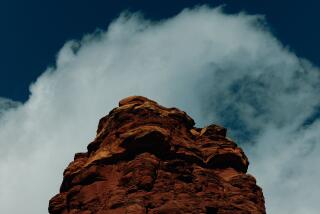Currency With Consciousness
- Share via
VEDIC CITY, Iowa — If Walt Disney World can make Disney Dollars and Club Med can print its own currency, then this Iowa town founded by practitioners of transcendental meditation figured that it too could make its own money.
The raam mudra, as the colorful notes are called, began circulating last month in this city incorporated last year by 125 followers of the Maharishi Mahesh Yogi, the Beatles guru and founder of the TM movement.
The currency has achieved a little consciousness-raising about Vedic City. But it has not created the wider monetary harmony that some had hoped for.
The idea in creating the money was to promote the city--a collection of onion-dome buildings set amid farmland about 100 miles from Des Moines--and its plans for a theme park devoted to world peace and the magic tricks of the late illusionist and TM practitioner Doug Henning.
The currency originally was intended to be used in Vedic City only, but thousands of meditators also live in Fairfield, a town of 8,700 two miles away. They also began to circulate the raam. Vedic City Mayor Bob Wynne asked businesses throughout Jefferson County to consider using the new currency.
But only Maharishi University of Management--which operates in Fairfield with more than 700 students--and a few businesses run by meditators accept the bills. Local banks, county officials and other merchants have balked.
County supervisors passed a resolution requiring homeowners to pay their property taxes in dollars, just in case anyone got the idea of using raam.
“We decided that we’re not a bank, that the function of exchanging money should be at a bank,” said county Supervisor Steve Burgmeier.
The First National Bank in Fairfield initially agreed to exchange raam for dollars but pulled out after a few weeks. Bank President Steve Cracker said First National feared that it could get stuck holding worthless raam.
Vedic City can legally make its own money, as long as it does not replicate U.S. currency, and people are free to use it. But Secret Service agent Chuck Hull warned: “Anybody who uses it does it at their own risk.”
The currency is named for Raam Mudra, the ancient Indian prince whose image appears on the notes. The colorful bills also feature Sanskrit messages of peace and prosperity, a cow and a wish-fulfilling tree.
One raam is worth $10. The one-raam note is green, the five-raam note blue and the 10-raam bill, worth $100, orange-yellow. The notes are printed in the Netherlands by the company that makes the euro.
TM adherent Mark Welch, who runs the Radio Shack in Fairfield, accepts raam. So does meditator Mel Sauerbeck, owner of a Fairfield photo studio. TM-connected stores exchange the bills among themselves in the course of business.
And the Vedic City Hall serves as an exchange service for those who want to change dollars to raam. Rogers Badgett, Vedic City mayor pro tem, said the colorful bills could become collector’s items.
“We’re excited about the excitement it’s creating,” he said. “We’ve had calls from all across the country from people who want to buy it or see it.”
The Maharishi brought his followers to Iowa in 1974, causing a stir among farmers and business owners. The meditators bought the trim red brick campus of bankrupt Parsons College in Fairfield. Within months, hundreds of people were assembling on campus for twice-daily meditation sessions.
Last year, university officials began tearing down original campus buildings--some on the National Register of Historic Places--to make room for new buildings facing east, to improve health and mental well-being.
But the neighbors and the meditators have learned to coexist.
“There are some things we agree to disagree on,” Burgmeier said.
More to Read
Sign up for Essential California
The most important California stories and recommendations in your inbox every morning.
You may occasionally receive promotional content from the Los Angeles Times.













